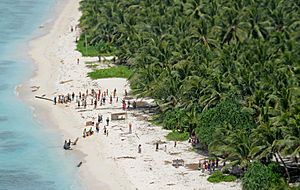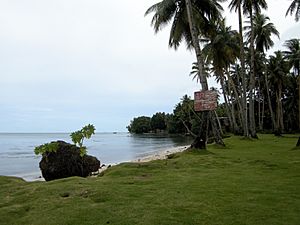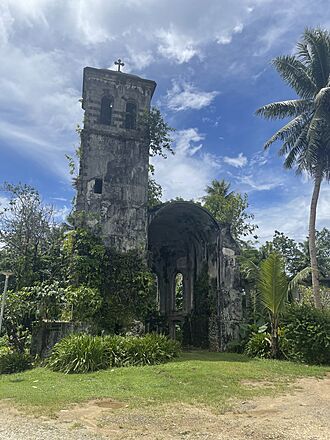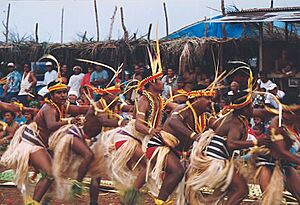Federated States of Micronesia facts for kids
Quick facts for kids
Federated States of Micronesia
|
|
|---|---|
|
|
|
|
Motto: "Peace, Unity, Liberty"
|
|
|
Anthem: "Patriots of Micronesia"
|
|
 |
|
| Capital | Palikir 6°55′N 158°11′E / 6.917°N 158.183°E |
| Largest city | Weno |
| Official language | English |
| Recognized regional languages |
|
| Ethnic groups
(2016)
|
|
| Religion
(2016)
|
|
| Demonym(s) | Micronesian |
| Government | Federal assembly-independent republic under a non-partisan democracy |
| Wesley Simina | |
| Aren Palik | |
| Legislature | Congress |
| Independence
from the United States
|
|
|
• Republic proclaimed
|
May 10, 1979 |
|
• Compact of Free Association
|
November 3, 1986 |
| Area | |
|
• Total
|
702 km2 (271 sq mi) (177th) |
|
• Water (%)
|
negligible |
| Population | |
|
• 2019 estimate
|
104,468 (181st) |
|
• Density
|
158.1/km2 (409.5/sq mi) (75th) |
| GDP (PPP) | 2019 estimate |
|
• Total
|
$367 million |
|
• Per capita
|
$3,584 |
| GDP (nominal) | 2019 estimate |
|
• Total
|
$383 million |
|
• Per capita
|
$3,735 |
| Gini (2013) | 40.1 medium |
| HDI (2022) | medium · 135th |
| Currency | United States dollar (USD) |
| Time zone | UTC+10 and +11 |
|
• Summer (DST)
|
not observed |
| Date format | MM/DD/YYYY |
| Driving side | right |
| Calling code | +691 |
| ISO 3166 code | FM |
| Internet TLD | .fm |
|
|
Micronesia, officially known as the Federated States of Micronesia, is an island nation in the Pacific Ocean. It is located northeast of Papua New Guinea. This country is an independent state that works closely with the United States. The capital city of the Federated States of Micronesia is Palikir.
The Federated States of Micronesia used to be part of the Trust Territory of the Pacific Islands. This was a territory managed by the United States under the United Nations. In 1979, they created their own constitution. In 1986, they became independent through an agreement called the Compact of Free Association with the United States. Today, Micronesia focuses on creating more jobs and protecting its ocean resources.
The Federated States of Micronesia includes hundreds of small islands. These islands are grouped into four main areas within the larger Micronesia region. The name Micronesia can refer to this country or the entire region of islands in Oceania.
Contents
History of Micronesia
The first people to live in Micronesia arrived over 4,000 years ago. They developed a system where local leaders (chiefs) governed. Over time, this system grew into a more organized culture. This culture was focused on trade and religion, especially around Yap Island.
Ancient Civilizations
Nan Madol is a special place that is a UNESCO World Heritage Site. It has many small artificial islands connected by canals. People sometimes call it the "Venice of the Pacific." Nan Madol is on the eastern side of Pohnpei island. It was the main center for leaders and religious ceremonies for the Saudeleur dynasty. This dynasty ruled about 25,000 people on Pohnpei from around 500 AD to 1500 AD. After 1500, their organized system ended.
European Exploration and Rule
European explorers first reached the Carolines in the 1500s. The Portuguese were looking for the Spice Islands. Then the Spanish arrived. A treaty called the Treaty of Tordesillas gave these lands to Spain. Spain then added the islands to their Spanish East Indies territory, governed from Manila. In the 1800s, Spain set up outposts and missions. In 1887, they founded a town called Santiago de la Ascensión. This town is now Kolonia on Pohnpei island.
In the 1870s, Germany started to expand its influence in the Caroline Islands. This led to a disagreement in 1885 called the Carolines Question. Pope Leo XIII was asked to decide if Germany or Spain had control. The Pope confirmed that Spain had authority. However, Germany was allowed to freely use the islands for trade.
After losing the Spanish–American War, Spain sold the islands to Germany in 1899. This was part of the German–Spanish Treaty of 1899. Germany then made the islands part of German New Guinea.
World Wars and Independence
During World War I, Japan took control of the islands. After the war, the League of Nations gave Japan a special permission to manage the islands. This was known as the South Seas Mandate.
During World War II, a large part of the Japanese navy was based in Truk Lagoon. In February 1944, a major naval battle called Operation Hailstone happened there. Many Japanese ships and planes were destroyed.
After World War II, the United States managed the islands. This was under the United Nations as part of the Trust Territory of the Pacific Islands.
On May 10, 1979, four districts of the Trust Territory agreed to a new constitution. They became the Federated States of Micronesia. Other islands like Palau, the Marshall Islands, and the Northern Mariana Islands chose not to join. The FSM signed a Compact of Free Association with the United States. This agreement started on November 3, 1986. It marked Micronesia's journey from being a trust territory to an independent nation. The United Nations officially ended the trusteeship in 1990. The agreement with the U.S. was renewed in 2004.
In 2015, the Federated States of Micronesia created the world's second-largest regional shark sanctuary. This protected area covers almost 3 million square kilometers of ocean.
Government and Politics
The Federated States of Micronesia is governed by its 1979 constitution. This constitution protects basic human rights. It also divides the government's powers into different branches. The national government is similar to, but not exactly like, the United States government.
The country has a single legislative body called the Congress. It has fourteen members who are chosen by popular vote. Four senators, one from each state, serve four-year terms. The other ten senators represent areas based on population and serve two-year terms. The Congress chooses the President and Vice President from the four state-based senators. They serve four-year terms as leaders of the country. When they become President or Vice President, special elections are held to fill their old Congress seats.
A group of appointed officials helps the President and Vice President. There are no formal political parties in Micronesia.
States of Micronesia
The Federated States of Micronesia is made up of four states. They are listed from west to east:
| Flag | States | Capital | Current Governor | Land Area | Population | Population Density |
||
|---|---|---|---|---|---|---|---|---|
| km2 | sq mi | per km2 | per sq mi | |||||
| Yap | Colonia | Charles Chieng | 118.1 | 45.6 | 16,436 | 94 | 243 | |
| Chuuk | Weno | Alexander R. Narruhn | 127.4 | 49.2 | 54,595 | 420 | 1088 | |
| Pohnpei | Kolonia | Reed P. Oliver | 345.5 | 133.4 | 34,685 | 98 | 255 | |
| Kosrae | Tofol | Tulensa Palik | 109.6 | 42.3 | 7,686 | 66 | 170 | |
These states are further divided into smaller areas called municipalities.
Geography and Nature
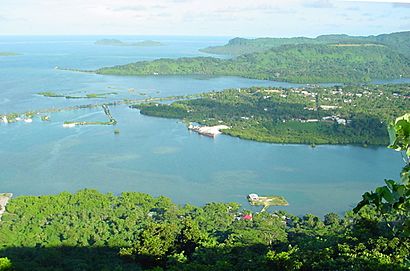
The Federated States of Micronesia has 607 islands. They stretch about 2,900 kilometers (1,800 miles) across the Caroline Islands. These islands are located east of the Philippines. All the islands together have a total land area of about 702 square kilometers (271 square miles).
The islands are grouped into four states: Yap, Chuuk (which was called Truk until 1990), Pohnpei (known as "Ponape" until 1984), and Kosrae (formerly Kusaie). Each of these four states is shown by a white star on the national flag. The capital city is Palikir, which is on Pohnpei.
Amazing Biodiversity
Micronesia is home to rich natural environments. Along the coast, you'll find mangrove forests, seagrass beds, lagoons, and coral reefs. These different areas are connected and support each other. About 300 types of coral, 1,000 kinds of fish, and 1,200 types of mollusks live in Micronesia. Mangrove forests are home to shrimps, crabs, fish, and birds that feed on them. Seagrass meadows grow offshore, past the mangroves. The lagoons provide food for creatures living in the reefs.
The coral reefs become more diverse and complex as you go from east to west. Kosrae has 150 types of hard coral, Pohnpei has 200, and Chuuk has 300. These coral reefs are among the most productive in the world. They absorb a lot of carbon, helping our planet.
Inland, from the coast to the mountain tops, there are many types of vegetation. These include cloud forests, palm forests, and areas with different kinds of trees and plants. There are about 1,230 species of ferns and flowering plants. About 782 of these are native to the islands. On Pohnpei Island alone, there are about 750 plant species, and 110 of them are found nowhere else.
Climate and Weather
The Federated States of Micronesia has a tropical rainforest climate. This means the weather is warm, humid, and rainy all year round. The islands are just north of the equator. Constant trade winds blow, which helps to keep the climate from getting too hot.
Temperatures usually stay between 22 and 25°C (72-77°F) at night. Daytime temperatures are between 30 and 32°C (86-90°F). There is a lot of rain, usually between 2,500 and 5,000 mm (98-197 inches) per year. Some areas facing the wind can get over 6,000 mm (236 inches) of rain. Mount Nahnalaud on Pohnpei island, which is only 750 meters (2,460 feet) high, gets an average of 10,160 mm (400 inches) of rain each year. This makes it one of the rainiest places on Earth, with skies that are almost always cloudy. Generally, the rain comes in short but very strong showers and storms. The driest places are the flat atolls, where rainfall can be less than 3,000 mm (118 inches). The months of January and February are the driest, but they still get at least 250 mm (10 inches) of rain and about 20 rainy days.
Languages Spoken
English is the official and most common language spoken. Besides English, many different Austronesian languages are also spoken:
| Rank | Language | Language family | Number of speakers |
|---|---|---|---|
| 1 | Chuukese | Micronesian | 45,900 |
| 2 | Pohnpeian | 30,000 | |
| 3 | Kosraean | 8,000 | |
| 4 | Mortlockese | 5,900 | |
| 5 | Yapese | Admiralty Islands? | 5,130 |
| 6 | Ulithian | Micronesian | 3,000 |
| 7 | Kapingamarangi | Polynesian | 3,000 |
| 8 | Pingelapese | Micronesian | 3,000 |
| 9 | Woleaian | 1,700 | |
| 10 | Mokilese | 1,500 | |
| 11 | Puluwat | 1,400 | |
| 12 | Pááfang | 1,300 | |
| 13 | Namonuito | 940 | |
| 14 | Nukuoro | Polynesian | 700 |
| 15 | Ngatikese | Micronesian | 700 |
| 16 | Satawalese | 500 | |
| 17 | Nguluwan | Admiralty Islands? | 50 |
| 18 | Ngatikese Creole | Creole | 30 |
Religion in Micronesia
Most people in the Federated States of Micronesia are Christian, making up about 97% of the population. More than half of the people (55%) follow the Catholic Church. About 42% belong to different Protestant Christian groups. This is mainly because of the history of Spanish and German rule in the islands.
Sports in Micronesia
Baseball
Baseball is a very popular sport in the Federated States of Micronesia.
Association Football
The sport of association football (soccer) in the Federated States of Micronesia is managed by the Federated States of Micronesia Football Association. They organize the Micronesian Games, which is the national football championship. They also oversee the Micronesia national football team.
FSMAA
The Federated States of Micronesia Athletic Association is the main organization for sports and athletics in the country.
Culture and Traditions
Each of the four states in Micronesia has its own unique culture and traditions. However, there are also common cultural and economic ties that have existed for centuries. For example, the importance of the traditional extended family and clan systems is found on all the islands.
Yapese Stone Money
The island of Yap is famous for its "stone money," known as Rai stones. These are large, round disks, usually made of calcite. They can be up to 4 meters (13 feet) wide and have a hole in the middle. The islanders know who owns each piece of stone money, so they don't always move them when ownership changes. There are five main types of these stones. Their value depends on their size and their history. Many of them were brought from other islands, some as far away as New Guinea, but most came from Palau long ago. There are about 6,500 of these stones scattered around Yap island.
Nan Madol World Heritage Site
Pohnpei is home to Nan Madol: Ceremonial Centre of Eastern Micronesia, which is a UNESCO World Heritage Site. However, the site is currently listed as In Danger because of natural causes. The government is working to protect and preserve this important historical site.
Music and Dances
Traditional dances on the main islands include "stick dancing" on Pohnpei, Chuuk, and Yap. There are also standing dances on Chuuk and sitting dances on Yap and Chuuk. The people of Yap are especially known for their dancing skills. The Yapese stick dance is performed by men, women, and children together. Standing dances are performed either by women or by men and boys, but never both groups together. Men take part in different dancing competitions. These are often separated by social groups. Lower social groups have some unique dances, like a woman's standing dance, but they can only dance when allowed by someone from a higher social group.
Images for kids
See also
 In Spanish: Estados Federados de Micronesia para niños
In Spanish: Estados Federados de Micronesia para niños





